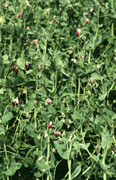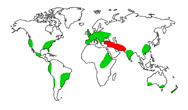Garden pea (Pisum sativum L.)
Pea family
(Fabaceae)

|

|
| Field pea (Peluschke) | Garden pea |
Source: Bock D., MPI; Wolf-Garten
Distribution, Yield, Use:
- Distribution:
Predominantly grown in Europe, China,
India and North America.
Prefers mild climate, tolerates light frost.
- Yield:
40-120 dt /ha green peas
10-50 dt /ha dried mature peas
- Use:
Foodstuff
- green peas as vegetable
(fresh, frozen, preserved)
- mature peas cooked for soup, broth
Fodder plant (seeds, green material)
Green peas contain
18-20% dry mass, 5-8% protein, 0.5% fat,
10-15% carbohydrate
Mature seeds contain
20-25% protein, 1-3% fat, 60% carbohydrate

Region of origin:  Region of cultivation:
Region of cultivation: 
- Cultivation and Breeding:
Today's cultivated peas probably originate from a wild type which is found from the mediterranean to Tibet. This wild pea (Pisum elatius) has tough pods when immature which split open on maturity, and small black seeds, only 3-5 mm in diameter. First the field pea arose from the wild pea by mutation, and from this arose the white-flowered Garden pea. Peas were probably already used as cultivated plants around 4000 BC in Near Asia. Directed selection in the choice of seeds led to a continual increase in size of the fruit and seed. Garden peas are divided into green peas (round smooth seeds) and marrowfats (seeds with wrinkled skins). Marrowfats with high amylose content are grown for starch production.
- Breeding aims:
General breeding aims are high yields with homogeneous maturity and resistance to disease. The processing industry demands uniform grading, attractive colour and a good taste. Green peas which split on boiling are preferred for the production of dried peas. For the fresh pea market, sweet marrowfat varieties with larger pods are sought after.
Text by
Dr. Wolfgang Schuchert
Adapted to HTML by R.Saedler



 Region of cultivation:
Region of cultivation: 